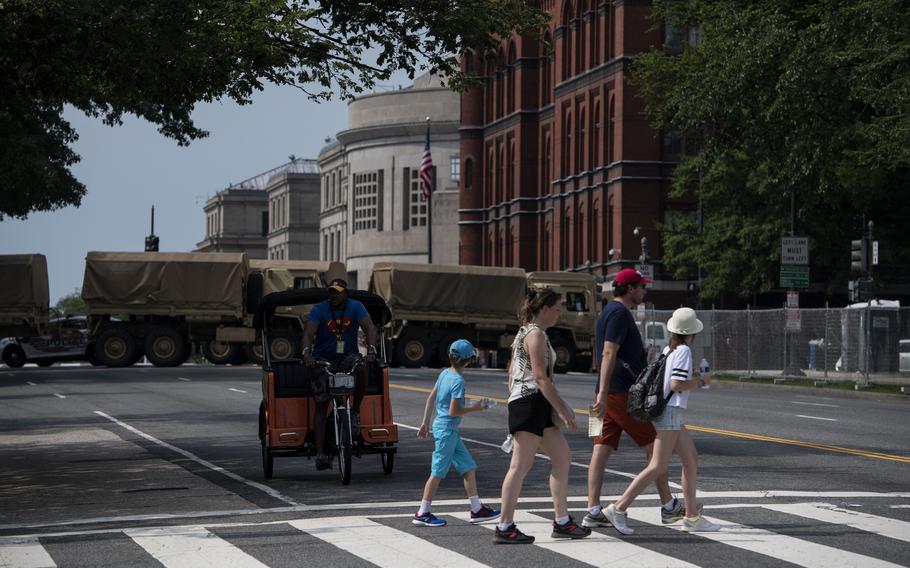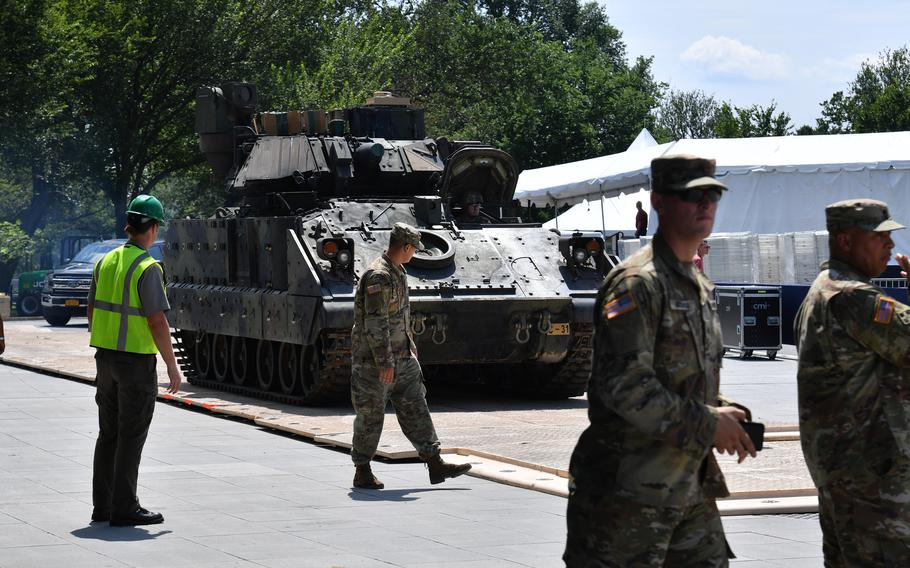U.S.
Army parade tanks will be a 70-ton test for DC streets
The Washington Post June 9, 2025

Trucks block a road before Independence Day festivities on the National Mall on July 4, 2019. (Carolyn Van Houten/The Washington Post)
Tanks scheduled to roll along the National Mall in a June parade for the Army’s 250th birthday are nearly double the weight limit allowed on D.C. roads without a permit, raising concern from D.C. officials about potential damage even as the Army has said it would foot the bill for any repairs.
For the spectacle Saturday — which is also President Donald Trump’s 79th birthday — thousands of soldiers, dozens of tanks and more than 100 other vehicles are scheduled for a procession on Constitution Avenue. The Army has stressed that it is taking protective measures to mitigate road damage, including installing metal plates at some potentially vulnerable points along the route, such as where the tanks will turn.
Constitution Avenue and other city roads maintained by local government generally support vehicles with a maximum gross weight of 80,000 pounds, according to the D.C. Department of Transportation. The Abrams main battle tanks — 28 of which are scheduled to participate in the parade — each weigh about 70 tons, almost double the street’s weight limit. The District requires a permit for any vehicle exceeding the limit. A spokesman for DDOT said that as of June 4, overweight-vehicle permits for the parade had been filed but were not yet finalized.
“We’ve worked really hard to get our roads in a state of good repair,” D.C. Mayor Muriel E. Bowser (D) said at a recent news conference. “I remain concerned about it, I have to tell you. These are, for the most part, local streets.”
NBC Washington has reported that street damage could total $16 million. Asked about this amount, Army spokesperson Steve Warren told The Washington Post: “It was an initial estimate for what it could cost if no mitigation efforts were taken. The worst-case scenario.”

A Bradley Fighting Vehicle sits on display near the Lincoln Memorial in 2019. (Marvin Joseph/The Washington Post)
During the parade, tanks will move at walking speed and are being fitted with new rubber track pads, which provide a buffer between the metal and the road surface, Warren said.
The protective plates will be placed along the route between Monday and Friday. “These measures will help ensure little or potentially even no damage to the roads,” Warren said.
If any city streets are “rendered unusable,” Bowser said, the city is likely to be responsible for fronting costs to fix them, and it would then seek reimbursement from the federal government.
The parade’s impact on the District will go beyond wear and tear on the roads. When asked whether the city would be reimbursed for other expenses such as trash collection, street closures and city police overtime, Army officials did not have an answer.
D.C. leaders said the pool of federal money they rely on to reimburse staffing and security expenses for activities associated with the federal government, such as the presidential inauguration, will be exhausted by the end of this fiscal year. Congress in December awarded D.C. $90 million for the Emergency Planning and Security Fund in fiscal 2025, which runs through October.
Trump’s proposed fiscal 2026 budget, introduced this month, offers just $39 million for the fund. Bowser said her office has been in “constant talks with the administration” about security funding and will aim to work with Congress to increase D.C.’s allotment.
“We think we need $100 million,” Bowser said.
Still, the mayor said the Army is well suited to handle military equipment with care — and without causing damage. “They have moved equipment in more precarious situations, so we’re relying on their expertise,” she said.
Military officials estimated that the sweeping celebration — which includes fireworks, a parachute jump and a full day of festivities on the National Mall — will cost the Army between $25 million and $45 million. The overall bill for the federal and city governments remains unclear.
During his first term, Trump walked back his plans for a military parade through the nation’s capital amid pushback over exorbitant costs and the damage armored vehicles might cause.
Special military equipment was displayed at 2019’s Fourth of July celebration on the Mall. Two M1A2 Abrams tanks were transported by train to a rail yard in Anacostia but never actually made it across the river. When he spoke, Trump was flanked by smaller Bradley Fighting Vehicles, which were rolled in on flatbed trucks to minimize road damage.
This year, 28 tanks will be joined by 28 Stryker armored personnel carriers, more than 100 other vehicles, a World War II-era B-25 bomber, 34 horses, two mules, a dog and some 6,600 soldiers. Fifty helicopters will buzz overhead.
Preliminary plans, which have been revised, called for the parade to begin at the Pentagon, traveling across the Arlington Memorial Bridge into Washington and continuing along Constitution Avenue NW, according to records reviewed by The Post.
Although some vehicles still will begin at a Pentagon parking lot, the heaviest vehicles, such as the tanks, will arrive in the region from Texas by rail and then be trucked overnight to West Potomac Park in D.C.
The switch was primarily due to practical concerns about where Pentagon workers would park. “You fill up the parking lot with tanks, where do the cars go?” Warren said. “Frankly, it was going to be annoying.”
On Saturday, the vehicles at the Pentagon will parade alongside troops marching across the bridge; a camera atop the Lincoln Memorial will capture the scene. They will then merge with equipment coming from West Potomac Park and continue about a mile along Constitution Avenue from near the Lincoln Memorial to the Washington Monument, roughly from 23rd Street NW to 15th Street.
Another concern that came up the first time Trump looked into a parade was potential damage to water drainage tunnels and other utilities. D.C. Water did not respond to a request for comment, but Metro should be safe from any impact as the route sidesteps the system’s tunnels.
“Everybody’s a little trepidatious about it,” Bowser said of the parade. “But hey, I think we’re going to have a lot of visitors to D.C. that are looking at the history of the Army and the equipment they are going to bring. So those are things that we still want to highlight.”
The celebration, the mayor added, “may be pretty spectacular.”
Rachel Weiner and Meagan Flynn contributed to this report.